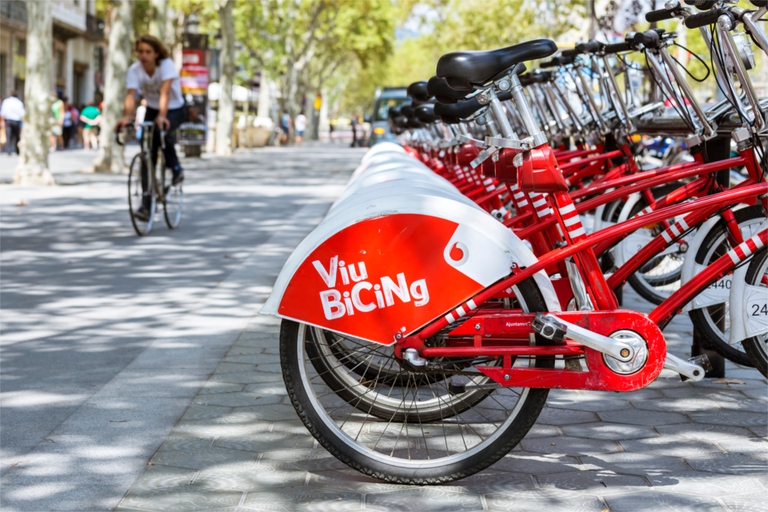
Milan has announced one of Europe’s most ambitious mobility schemes, known as Strade Aperte (open roads). Its goal is to reduce cars in phase 2 of the lockdown by increasing bike lanes and pedestrian areas.
The cycling lane network in Barcelona will increase from 116 to 308 km in three years with an investment of 32 million euros. The urban mobility plan also aims to create new bike parking lots.
Barcelona decided to invest heavily in bike facilities: 32 million euros to triple the length of the city’s cycling lanes (from 116 to 300 km) in three years. This is a significant investment for a city that besides counting 1,600,000 inhabitants has a surface of a little less than 100 km2. The goal is to expand and improve the existing network of cycling lanes in order to build a continuous, safe and comfortable network.
Barcelona’s urban mobility plan for 2013-2018 aims to increase by 67% the use of bicycles, from 1.5 of daily journeys to 2.5%, reducing the use of cars by 21%. Another way to promote alternative means of transport at the expense of cars is a superblock: a block surrounded by heavy traffic roads where bicycles, residents’ cars and emergency vehicles only can travel. This method also promotes walking, thus reducing noise pollution within the blocks, which may also become semi-pedestrian areas.
Currently, 72% of Barcelona’s inhabitants have a bike lane available within 300 metres, but this figure will increasingly improve thanks to the new investments, until it becomes 95%.
Barcelona’s cycling lanes will join the “30 zones”, where the speed limit is 30 km/h. The lanes will also be built along the busiest streets in order for those who ride to work to have more comforts.
The urban mobility plan also aims to increase the number of bike parking lots that safeguard bikes from vandalism, thefts, atmospheric agents, are useful for those who use them and aren’t too expensive.
With the results obtained so far Barcelona managed to rank eleventh in the 2015 Copenhagenize Index, just after Seville: with the new investments the city won’t have problems in making it to the top ten.
Another important contribution to promote the use of bicycles is given by Bicing, the bike sharing system of the Catalan city. Created in 2007 it now counts 6,000 bicycles, 420 bike parking stations and almost 100,000 subscribers, and in 2017 people will be able to sign another type of contract to expand the service.
Siamo anche su WhatsApp. Segui il canale ufficiale LifeGate per restare aggiornata, aggiornato sulle ultime notizie e sulle nostre attività.
![]()
Quest'opera è distribuita con Licenza Creative Commons Attribuzione - Non commerciale - Non opere derivate 4.0 Internazionale.
Milan has announced one of Europe’s most ambitious mobility schemes, known as Strade Aperte (open roads). Its goal is to reduce cars in phase 2 of the lockdown by increasing bike lanes and pedestrian areas.
Formula 1, the world’s most important auto racing championship, has decided to turn the page and aim for carbon neutrality with the support of its teams, drivers and the whole racing circus.
Seville dreams big about cycling mobility, in the wake of the actions undertaken by cities like Nantes or Lubiana; so, not exclusively Northern Europe can invest adequately in bicycles as the means of transport of the future. Figures on bike infrastructures in Seville From 2006 to 2011, in the Spanish city the number of cyclists increased tenfold,
Toyota and LifeGate began telling the story of hybrid mobility back in 2006, now, on the road to the Tokyo 2020 Olympics, they’re still treading the path of sustainable mobility. Here are the main steps of the journey.
Germany’s first solar bicycle lane could be the prototype for the roads of the future. The photovoltaic tiles melt snow and ice, and are capable of absorbing noise.
The Vespa is back in an electric version. Production has just started and the first models can be reserved online starting from October.
The city of Utrecht, in the Netherlands, is home to a bridge for cycling and walking that stretches over roof garden of a Montessori school. This project enhances practicality and will allow families to bring children to school by bike, passing through green areas. Despite their functionality, bridges are often seen as an infrastructure that is
The Lego hair bike helmet is the latest Internet craze. For now it’s just a prototype but production on a large scale will probably start soon.
Just as fires often give way to new growth, after the Dieselgate scandal, which saw Volkswagen cheating on US emission rules, the German car manufacturer radically changed course, beginning to focus on sustainable mobility. The German car company aims to propose thirty zero-emission models and produce at least one million battery electric vehicles by 2025. An ambitious mission








